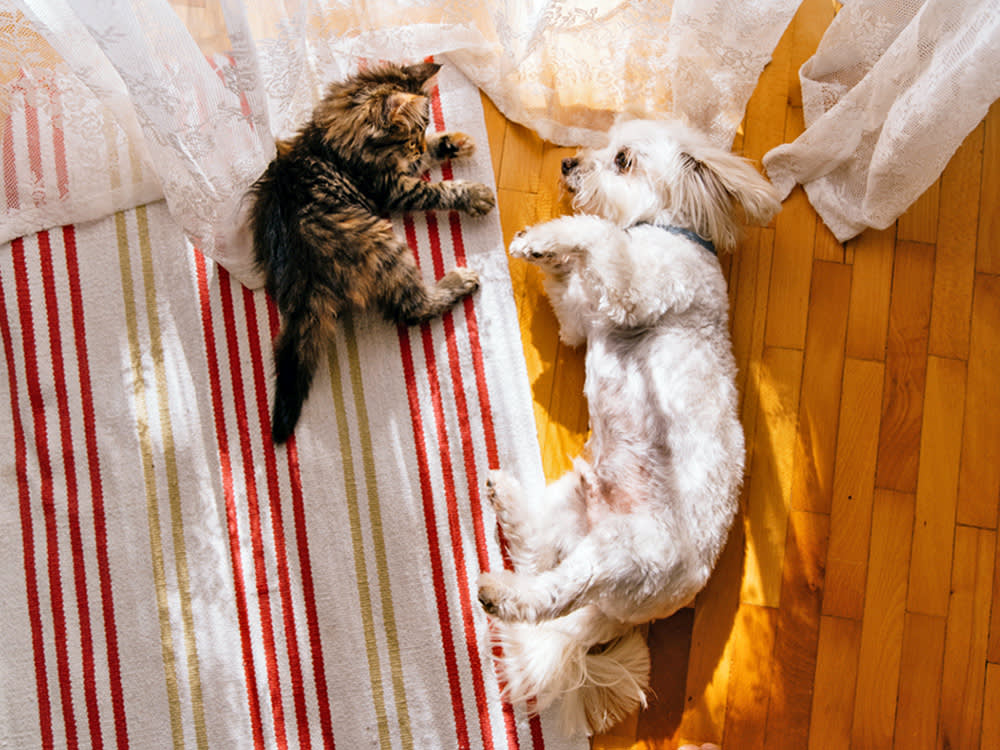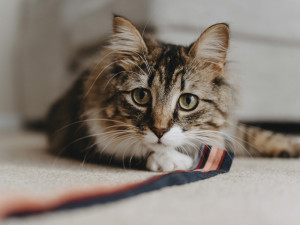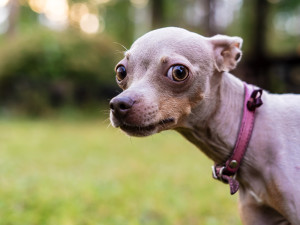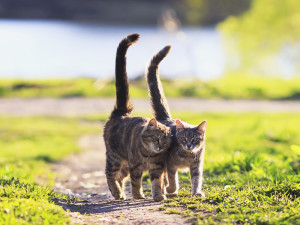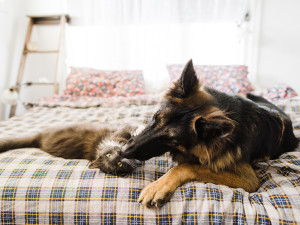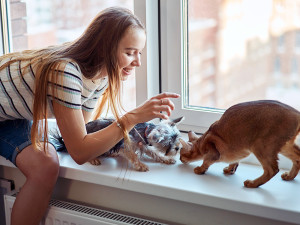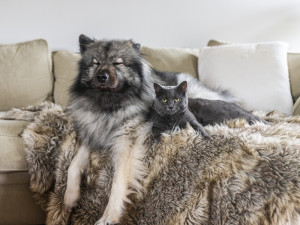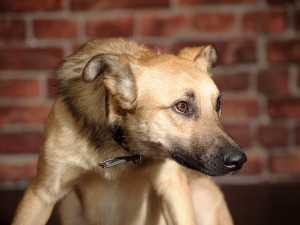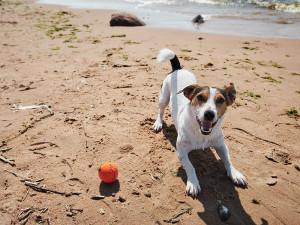How Dogs and Cats Communicate With Each Other
There might be a language barrier, but these two animals can still become best buds
A few weeks ago, my cat Kobe met a dog for – what I assume – was the first time (who really knows what animal pals he might make while he’s on his outdoor adventures). My friend brought her very well-behaved Boston Terrier, Poppy, round to my house for the evening. I wasn’t sure how Kobe would react: whether he’d stay hidden upstairs under the bed in fear, be friendly or perhaps even be angry and territorial.
What actually happened was that he stood on the stairs staring intently at Poppy all evening, who gave him a good run for his money in the staring contest stakes for a little while before she settled down and ignored him completely. But while defending his upstairs territory, I noticed that Kobe was giving Poppy a series of very pronounced slow blinks. We know that when cats slow blink at humans, it can be a sign of affection or contentment, but when cats slow blink at one another, it also means they are communicating that they are friendly and not threatening to the other cat. Naturally, as a non-native cat speaker, Poppy didn’t respond in the same way and I wondered whether Kobe might be offended or confused that Poppy wasn’t returning his ‘friendly’ gesture.
So, can dogs and cats speak the same language? How do they communicate with one another? We spoke to the experts to find out.
How do dogs and cats communicate with their own species?
Dogs
While we might think that barks and growls are all that’s in a dog’s communication arsenal, they actually use most of the senses, including smells, sounds, visual cues and body language to communicate. “It’s also all about context,” explains trainee animal behaviourist Lottie Phillips. “When two dogs meet, they’re not only listening to vocalisations, but they’re also looking at body language (posture, ear and tail position, eye contact) and interpreting scents from the other dog’s anal glands.” The adrenaline and pheromones secreted from the anal glands communicate details about a dog’s health, sex, diet, social status and mood, says Lottie. That explains all the bum sniffing then.
Tail wise, a low, slow and relaxed wag may mean they feel content and at ease, while a quick and vigorous wag of a tail held high may signal arousal and excitement. Meanwhile, if your dog’s ears are perked up and facing forwards, it suggests they’re interested or alert, but if their ears are flat against the head, it could be a sign of anxiety or fear. And if their ears are tightly pinned back, it could indicate discomfort or even potential aggression.
“A happy dog will have a relaxed body with a wagging tail and may even invite humans and other dogs to play with a play bow,” says Lottie. “In contrast, a dog with a tense body and raised hackles (piloerection) may be stressed or feeling aggressive.”
These are all cues that other dogs will instinctively understand, making communication a breeze between them.
Cats
Cats also use a similar combination of communication cues: vocalisations, scent and body language. Cats use scent to mark their territory, identify familiar cats and find mates. “In the vocalisation department, some cats will meow or trill in greeting, or they might growl, snarl, spit or hiss as a way to tell other cats to back off,” says Lottie.
Not all cats will meow in greeting to each other, but many of them will touch noses or rub against each other as a way to say hello. “A cat’s ears, eyes and tail are especially important in displaying body language,” says Lottie. “A friendly, confident cat holds their tail high with ears perked forwards.” But if your cat averts their eyes or if they tuck their tail in under their body, it can be a sign that they feel uncomfortable or even threatened. “Aggressive behaviour can manifest as ears flattened against their head, a lashing tail, bristling fur, trying to make themselves appear larger, and an arched back,” explains Lottie.
And what about those slow blinks? “Slow blinking is a gesture of trust and affection that cats use to communicate with each other. When a cat slow blinks, it's a sign that they feel comfortable and safe around you,” says Lottie.
How do dogs and cats communicate with each other?
Cats and dogs tend to be considered polar opposites, and not without good reason. Dogs are more domestic and loyal, eager to snuggle up to their favourite human, while cats are known as more independent. We know both cats and dogs use scent, body language and sound to communicate with one another, but what are the chances these two can learn to overcome their language barrier?
Studiesopens in new tab say that although dogs have been domesticated for far longer than cats (30,000 years ago versus 10,000 years ago), both species have learnt how to interpret human behaviour, specifically our gaze and body language. “This level of intelligence and adaptability also indicates that if they’re able to figure out human cues, they may also be able to understand communication patterns from other animals,” says Lottie.
Dogs and cats may also find connections between another animal’s behaviours and the reactions or rewards that are associated with them. “If a cat and dog live in the same household, they usually learn to interpret the other species’ body language cues after a while,” says Lottie. “For example, even though tail wagging for dogs is friendly, it signals irritation or aggression in cats. But if the cat and dog spend enough time with each other, they will learn from observation what those tail wags mean – if the cat wags their tail and then swats at the dog, over time the dog will learn that the tail wag equals something bad.”
Cats and dogs will also sometimes learn to integrate the other pet’s communication techniques. For instance, well-socialised dogs are often willing to adaptopens in new tab by greeting cats with nose-to-nose sniffing and will accept head rubbing, as opposed to their usual butt sniffing or play bowing.
However, it really all does come down to the individual personalities and temperament of both animals, and when it comes to introducing dogs to cats, studiesopens in new tab have shown that it is best if the cat was living in the home before the pup arrived because cats are typically so territorial.
Fighting like cats and dogs
The examples of dogs and cats learning to communicate successfully with one another do tend to relate to animals who live in the same household, are trained by their pet parents to act non-aggressively and have spent prolonged time together. In general, cats and dogs have a natural tendency towards antagonistic relationships between species. “Dogs have an instinct to chase smaller animals that flee, and cats have a natural instinct to flee from dogs, while others might hiss, arch their backs or swipe at the dog,” says Lottie. “In turn, after being scratched by a cat, most dogs will become fearful of cats.”
If you’re hoping to have a harmonious cat-dog household, don’t worry. There are a few ways you can work towards this and help your pets to speak the same language.
How to train your dog and cat to be friends
While you may have visions of your cat and dog snuggling up on the couch or playing together, it’s far more likely that both animals will be a bit hesitant around each other at first. That’s why it’s important to take things very slowly and give both animals time to get used to one another.
“Change can be stressful for cats, so be sure to keep things as stable and consistent as you can,” says Dr Mikel Delgado, certified cat behaviour consultant. “Provide them with a regular routine of attention and play… I’ve seen plenty of cats become best buds with a dog when the introduction is done carefully and slowly!”
Introducing a new dog to your existing cat
Let’s imagine you already have a cat and you’re planning to introduce a dog into the home (which is the ideal way round to do it). Firstly, it’s important that you take the time to find a dog whose personality fits well with your cat and your lifestyle. Most cats and dogs are more likely to tolerate (and maybe even like) animals with similar dispositions, so if you have an outgoing cat, look for an active dog or try pairing your lazy older cat with a more stoic canine companion.
You can also look for a dog who has had experience living with cats in the past or has at least done well with cats in the shelter or foster home, but keep in mind that one experience is no guarantee that a dog will like every cat they meet. And even if your cat has done well with a dog in the past, they may not like the new addition to the family.
“Each animal has their own personality and feelings about other animals. Just because a cat liked one dog in the past does not mean they will greet every dog with open arms. However, one bad experience with a dog can have a serious impact on whether that cat will accept a dog in the future. That is why it is so important to go slowly and help each pet make positive associations with the other,” says Dr Delgado.
Once you’ve found the right pup for your family, you will need to prepare your home – and your cat. Take some time to rearrange the layout so your cat has plenty of space to retreat and feel safe. Make sure the litter box and cat food are in a place where the dog can’t reach them. Provide plenty of spots where your cat can jump up to safety if they choose and escape an energetic and curious pup. This can include tall cat trees or wall pieces for your cat to climb on, allowing them to watch the dog from a distance and flee the room if they’ve had enough.
Step one: scent
As cats and dogs both use scents to communicate, before your dog and cat ever meet face-to-face, try introducing their scents to one another. “I recommend starting by getting them used to each other’s scent by exchanging bedding, letting each pet explore the other’s bedding at their own pace,” says Dr Delgado.
Each pet can separately sniff the other without seeing them, giving them time to get used to one another’s presence and (hopefully) making their first actual meeting less stressful for all involved. And don’t forget to reward positive behaviour, Dr Delgado emphasises.Step two: introduce both pets in a controlled environment
When your pets finally meet face-to-face, make sure your dog is on the lead and both animals are calm – or as calm as they can be. You may even want to have an extra barrier between your pets, like that baby gate. Choose a meeting space where your cat has places to escape to higher ground, and make sure to reward your dog and your cat with praise and treats for calm behaviour. Continue introducing the two pets with your dog on a lead for several days, and when you’re away, always make sure the dog is in a crate, pen or separate room where they can’t reach the cat without supervision.Step three: try supervised interactions
Once your dog and cat have met each other for about a week with no negative interactions (that is, no attempted attacks, hissing or growling), try an unleashed meeting. Stay close and keep an eye on both animals so you can quickly separate them if things get heated. Keep rewarding your dog and cat both for remaining calm and watch for any hints of aggression, stress or tension.
If supervised interactions continue to go well, you can start leaving your dog and cat alone together unsupervised for brief periods of time. Start with just a few minutes and work your way up to longer unsupervised meetings. Before you know it, your two pets will be casually chilling in the same space (which is way more exciting than it sounds).
Communication is key
Any time cats and dogs interact, it’s important to pay close attention to how they’re communicating. Here are a few key signs to look out for:
The dog is really focused on the cat. This could indicate that their predatory instincts are kicking in and may be the first sign of a lunge or attack. Recall the dog and reward them with treats when they come. If recall doesn’t work, separate the two animals.
Your cat’s habits (eating, drinking, litter box use) change. If these habits don’t go back to normal in a few days, your cat may be experiencing stress or anxiety.
Either the cat or dog acts aggressively when the other pet is calm. If either animal acts out in aggression without being provoked, they may not be friendly towards the other species, and it’s important to separate them straight away.
So while dogs and cats may not always end up having the loving relationships we covet on those ultra-cute viral videos, with time and patience (from you and them), they can learn to communicate, to understand one another and to hopefully live a laid-back, amicable life together.
